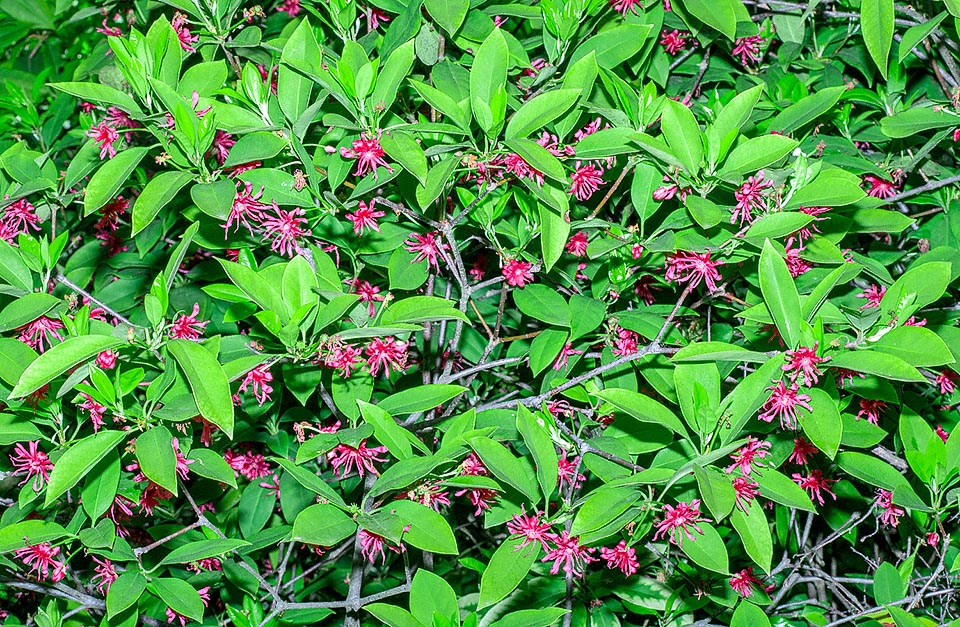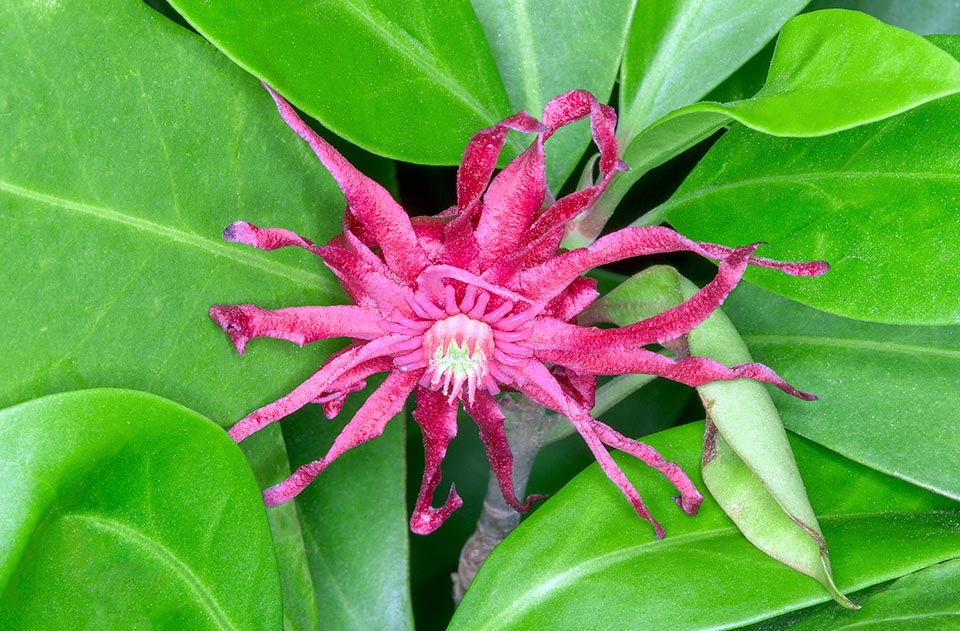Family : Schisandraceae

Text © Pietro Puccio

English translation by Mario Beltramini
The species is native to Mexico (Hidalgo, Puebla, San Luis Potosí, Tamaulipas and Veracruz) and USA (Alabama, Florida, Georgia, Louisiana and Mississippi) where it grows in the under-wood of the humid forests, in swampy areas, in the bottom of ravines and on the steep banks on the margins of water streams.
The name of the genus is the Latin substantive “illicium, illicii” = enticement, bait, seduction, with reference to the fragrance of many of its species; the Latin specific name refers to the place of origin of the type species, Florida (USA).
Common names: Florida anise, Florida anisetree, purple anise, star anise, stinkbush (English).
The Illicium floridanum J.Ellis (1770) is a shrub, or small erect evergreen tree, very ramified, compact, 1,5-3 m tall in cultivation, up to about 8 m in the old specimens in nature, expanding through root suckers.
The leaves, on a 1-2,5 cm long initially reddish petiole, are alternate, spirally arranged, often grouped at the end of the branch thus looking verticillate, simple, elliptic-lanceolate with acute or acuminate apex and entire margin, 5-18 cm long and 2-5 cm broad, thick, coriaceous, of glossy dark green colour above, paler below, the leaves if rubbed emit an anise smell.

Present in Mexico, Florida and other states of USA, Illicium floridanum is an evergreen shrub or small tree very ramified, that reaches in cultivation the 3 m of height getting close in nature to the 8 m in oldest specimens. The leaves when rubbed emit a pleasant smell of anise but are toxic as well as all other parts of the plant © Giuseppe Mazza
Solitary, axillar flowers, on a 1-6 cm long peduncle, often curved, bisexual, but self-compatible, of 3-5 cm of diameter, produced in spring for about one month or little longer. Calyx formed by 3-6 sepals, precociously caducous, oblong-ovate with obtuse apex, concave, about 1 cm long. Corolla formed by 21-33 free petals arranged in 3 series, linear-lanceolate with obtuse apex in the external and intermediate series, acute in the internal one, 1,5-2,5 cm long, of dark red to purple to reddish brown colour, rarely pink or white. 25-50 stamens, circularly arranged, erect, with filaments of the same colour as the petals, and superior ovary with 11-21 free carpels arranged in verticil, compressed laterally, with styles bent outwards; the flowers emit an unpleasant odour at short distance.
The fruit, of 2,5-4 cm of diameter, is formed by 11-15 oblong-ovoid follicles circularly arranged, initially of green colour, then brown when ripe, containing one seed each that when ripe is expelled in an explosive way up to more than 3 m. The seeds are ellipsoid, compressed laterally, of brown colour and glossy. Several varieties have been selected with bigger flower of different colour, white to dark red, with variegated leaves and more compact posture.

Unusual flowers of 3-5 cm of diameter, usually purplish. Easy to cultivate. Good resistance to parasites. It bears well the pruning, the warm and the cold up to -10 °C © Giuseppe Mazza
It easily reproduces by seed in organic loam, with addition of coarse siliceous sand per a 30%, maintained humid at the temperature of 22-26 °C, by woody or semi-woody cutting, offshoot, layering and through root suckers.
Species with very ornamental foliage and interesting blooming that thanks to its easy cultivation, rusticity and resistance to diseases and parasites has had since the last years of the XX century, along with the selected varieties, an always increasing utilization in the gardens as isolated specimen, in mass, for borders and fences.
Of relatively slow growth, it bears high and low temperatures, up to about -10 °C, and the full sun, if well irrigated, but for getting a more intensely coloured foliage it is preferable a position from slightly shady to shady. It grows in an ample variety of soils, provided draining and maintained almost constantly humid, even is when well rooted it can bear short dry periods, with preference to those sandy, acidic or neutral, rich of organic substance. It bears well the pruning and with repeated interventions it can be also grown as tree. All parts of the plant are toxic if ingested, it is therefore necessary to pay attention in presence of children and animals.
Synonyms: Illicium reticulatum Raf. (1840); Badianifera floridana (J.Ellis) Kuntze (1891); Illicium mexicanum A.C.Sm. (1947); Illicium floridanum f. album F.G.Mey. & Mazzeo (1992).
→ To appreciate the biodiversity within SCHISANDRACEAE family please click here.
